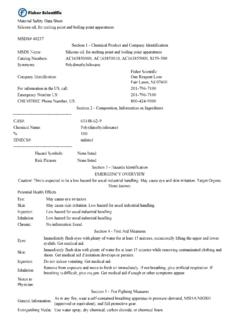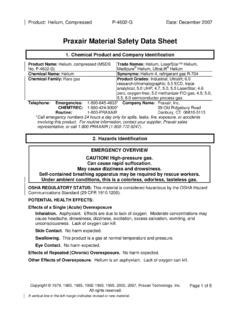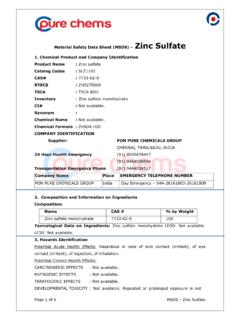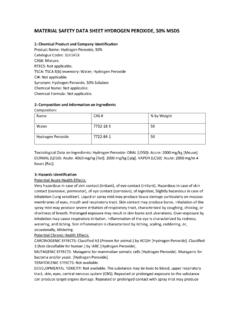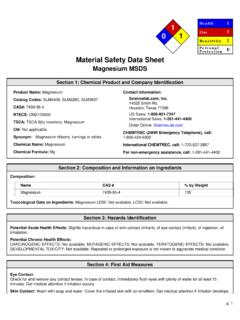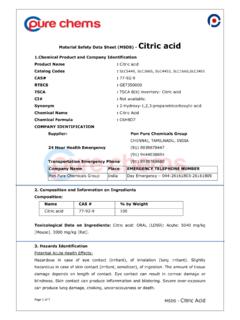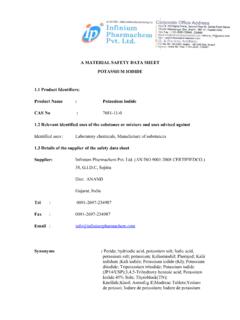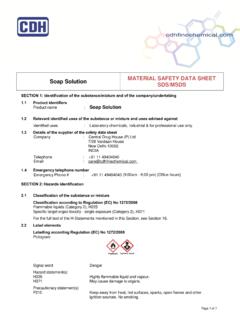Transcription of KI Material Safety Data Sheet Chemical Name: Potassium ...
1 P. 1 0 1 0H e a l t hF i r eR e a c t i v i t yP e r s o n a lP r o t e c t i o n100 EMaterial Safety data SheetPotassium Iodide MSDSS ection 1: Chemical Product and Company IdentificationProduct Name: Potassium IodideCatalog Codes: SLP2050, SLP1042, SLP2854 CAS#: 7681-11-0 RTECS: TT2975000 TSCA: TSCA 8(b) inventory: Potassium IodideCI#: Not : Chemical Name: Potassium IodideChemical Formula: KIContact , Smith , Texas 77396US Sales: 1-800-901-7247 International Sales: 1-281-441-4400 Order Online: (24HR Emergency Telephone), call:1-800-424-9300 International CHEMTREC, call: 1-703-527-3887 For non-emergency assistance, call: 1-281-441-4400 Section 2: Composition and Information on IngredientsComposition:NameCAS #% by WeightPotassium Iodide7681-11-0100 Toxicological data on Ingredients: Potassium Iodide LD50: Not available. LC50: Not available. Lowest Published LethalDose: LDL [Mouse] - Route: Oral; Dose: 1862 mg/kg LDL [Rabbit] - Route: Oral; Dose: 916 mg/kgSection 3: Hazards IdentificationPotential Acute Health Effects: Slightly hazardous in case of skin contact (irritant), of eye contact (irritant), of ingestion, Chronic Health Effects:CARCINOGENIC EFFECTS: Not available.
2 MUTAGENIC EFFECTS: Mutagenic for mammalian somatic EFFECTS: Not available. DEVELOPMENTAL TOXICITY: Classified Reproductive system/toxin/female,Development toxin [POSSIBLE]. The substance may be toxic to thyroid. Repeated or prolonged exposure to the substancecan produce target organs 4: First Aid MeasuresEye Contact:p. 2 Check for and remove any contact lenses. In case of contact, immediately flush eyes with plenty of water for at least 15minutes. Cold water may be used. Get medical attention if irritation Contact:Wash with soap and water. Cover the irritated skin with an emollient. Get medical attention if irritation develops. Cold watermay be Skin Contact: Not :If inhaled, remove to fresh air. If not breathing, give artificial respiration. If breathing is difficult, give oxygen. Get Inhalation: Not :Do NOT induce vomiting unless directed to do so by medical personnel. Never give anything by mouth to an unconsciousperson.
3 If large quantities of this Material are swallowed, call a physician immediately. Loosen tight clothing such as a collar,tie, belt or Ingestion: Not 5: Fire and Explosion DataFlammability of the Product: Temperature: Not Points: Not Limits: Not of Combustion: Some hazardous decomposition products are: Hydrogen Iodide, Oxides of Potassium , iodineFire Hazards in Presence of Various Substances: Not Hazards in Presence of Various Substances:Risks of explosion of the product in presence of mechanical impact: Not available. Risks of explosion of the product inpresence of static discharge: Not Fighting Media and Instructions: Not Remarks on Fire Hazards: Not Remarks on Explosion Hazards: Potassium iodide + Fluorine Perchlorate will explode on 6: Accidental Release MeasuresSmall Spill:Use appropriate tools to put the spilled solid in a convenient waste disposal container. Finish cleaning by spreading water onthe contaminated surface and dispose of according to local and regional authority Spill:Use a shovel to put the Material into a convenient waste disposal container.
4 Finish cleaning by spreading water on thecontaminated surface and allow to evacuate through the sanitary 7: Handling and StoragePrecautions:Do not breathe dust. Wear suitable protective clothing. If you feel unwell, seek medical attention and show the label whenpossible. Keep away from incompatibles such as oxidizing agents, reducing agents, metals, acids, 3 Storage:Moisture Sensitive. Light Sensitive. Air SensitiveKeep container tightly closed in light-resistant containers. Keep container in acool, well-ventilated 8: Exposure Controls/Personal ProtectionEngineering Controls:Use process enclosures, local exhaust ventilation, or other engineering controls to keep airborne levels below recommendedexposure limits. If user operations generate dust, fume or mist, use ventilation to keep exposure to airborne contaminantsbelow the exposure Protection: Safety glasses. Lab coat. Dust respirator.
5 Be sure to use an approved/certified respirator or Protection in Case of a Large Spill:Splash goggles. Full suit. Dust respirator. Boots. Gloves. A self contained breathing apparatus should be used to avoidinhalation of the product. Suggested protective clothing might not be sufficient; consult a specialist BEFORE handling Limits: Not 9: Physical and Chemical PropertiesPhysical state and appearance: Solid. (Deliquescent crystals solid.)Odor: : Bitter. Saline. (Strong.)Molecular Weight: 166 g/moleColor: (1% soln/water): Not Point: 1330 C (2426 F)Melting Point: 681 C ( F)Critical Temperature: Not Gravity: (Water = 1)Vapor Pressure: Not Density: Not : Not Threshold: Not Dist. Coeff.: Not (in Water): Not Properties: See solubility in water, methanol, :Easily soluble in cold water, hot water. Soluble in methanol. Partially soluble in 10: Stability and Reactivity DataStability: The product is 4 Instability Temperature: Not of Instability:Light, moisture, incompatible materials.
6 It is stable under ordinary conditions of use and storage. On long exposure to air, itbecomes yellow due to release of with various substances: Reactive with oxidizing agents, reducing agents, organic materials, metals, :Corrosive in presence of steel, of aluminum, of zinc . Non-corrosive in presence of glass, of copper, of stainless steel(304), ofstainless steel(316).Special Remarks on Reactivity:Moisture Sensitive. Light Sensitive. Air Sensitive. Air causes decomposition to iodine. Reacts violently with strong oxidizers,bromotrifluorides, chlorotrifluorides, fluorine perchlorate, metallic salts. Attacks metals in moist environments. Alsoincompatible with salts of alkaloids, chloral hydrate, calomel (mercurous chloride), Potassium chlorate, tartaric and otheracids, oxidants, diazonium salts, charcoal, ozone, strong reducers, alkali metals, metals (brass, aluminum magnesium, zinc ,cadmium, copper, tin, nickel, steel), metallic salts, organic materials, Remarks on Corrosivity:Incompatible with water, producing a corrosive.
7 Corrosive in all concentrations to most metals, except stainless steel, titanium,and : Will not 11: Toxicological InformationRoutes of Entry: Inhalation. to Animals:LD50: Not available. LC50: Not Effects on Humans:MUTAGENIC EFFECTS: Mutagenic for mammalian somatic cells. DEVELOPMENTAL TOXICITY: Classified Reproductivesystem/toxin/female, Development toxin [POSSIBLE]. May cause damage to the following organs: Toxic Effects on Humans: Slightly hazardous in case of skin contact (irritant), of ingestion, of Remarks on Toxicity to Animals:Lowest Published Lethal Dose: LDL [Mouse] - Route: Oral; Dose: 1862 mg/kg LDL[Rabbit] - Route: Oral; Dose: 916 mg/kgSpecial Remarks on Chronic Effects on Humans:Can cause adverse reproductive efects and birth defects based on animal data . May affect genetic Material based on animaldataSpecial Remarks on other Toxic Effects on Humans:Acute Potential Health Effects: Skin: May cause skin irritation.
8 Eyes: May cause eye irritation. Inhalation: May causerespiratory tract and mucous membrane irritation and a productive cough. May cause pulmonary edema and inflammationof the tonsils. Ingestion: Causes gastrointestinal tract irritation with nausea, vomiting and diarrhea. May affect behavior(somnolence, muscle weakness), respiration (dyspnea). Serum-sickness type of hypersensitivity such as fever, arthralgia,lymph node enlargement , and eosinophilia may appear. Thrombotic thrombocytopenic purpura, and fatal periarteritis nodosaattributed to hypersensitivity to iodide has been described. Chronic Potential Health Effects: Can lead to iodism characterizedby salivation, nasal discharge, sneezing, conjunctivitis, fever, headache, laryngitis, bronchitis, stomatits, parotitis, anemia, andskin rashes. Chronic ingestion may also affect metabolism (anorexia), and thyroid gland (hypothyroidism, goiter).
9 Furthermore,chronic ingestion of iodides (in animals) during pregnancy has resulted in fetal deaths, severe goiter and cretinoid appearanceof the 12: Ecological InformationEcotoxicity: Not and COD: Not 5 Products of Biodegradation:Possibly hazardous short term degradation products are not likely. However, long term degradation products may of the Products of Biodegradation: The product itself and its products of degradation are not Remarks on the Products of Biodegradation: Not 13: Disposal ConsiderationsWaste Disposal:Waste must be disposed of in accordance with federal, state and local environmental control 14: Transport InformationDOT Classification: Not a DOT controlled Material (United States).Identification: Not Provisions for Transport: Not 15: Other Regulatory InformationFederal and State Regulations: TSCA 8(b) inventory: Potassium IodideOther Regulations: EINECS: This product is on the European Inventory of Existing Commercial Chemical Classifications:WHMIS (Canada): CLASS D-2A: Material causing other toxic effects (VERY TOXIC).
10 DSCL (EEC):Not available Not ( ):Health Hazard: 1 Fire Hazard: 0 Reactivity: 0 Personal Protection: ENational Fire Protection Association ( ):Health: 1 Flammability: 0 Reactivity: 0 Specific hazard:Protective Equipment:Gloves. Lab coat. Dust respirator. Be sure to use an approved/certified respirator or equivalent. Wear appropriate respiratorwhen ventilation is inadequate. Safety 16: Other InformationReferences: Not 6 Other Special Considerations: Not : 10/11/2005 12:21 PMLast Updated: 11/01/2010 12:00 PMThe information above is believed to be accurate and represents the best information currently available to us. However, wemake no warranty of merchantability or any other warranty, express or implied, with respect to such information, and we assumeno liability resulting from its use. Users should make their own investigations to determine the suitability of the information fortheir particular purposes.



